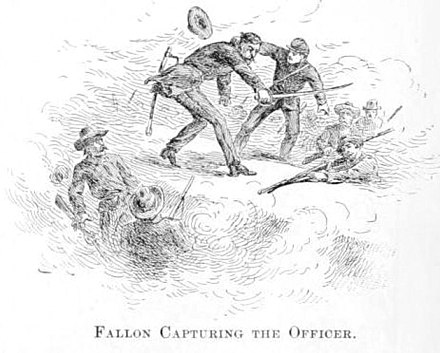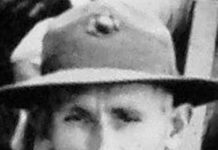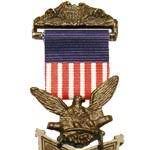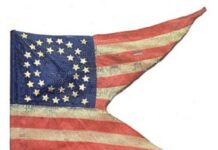Private Thomas T. Fallon
Private Thomas T. Fallon, a native of County Galway, Ireland was born Aug. 12, 1837, and emigrated to the United States when he was 22 years old. Two years later, in 1861, at the start of the Civil War, he enlisted in Company K of the 37th New York “Irish Rifles”.
His war time service spanned more than 20 different engagements in at least three different units of the military.
Medal of Honor
His first encounter was during the campaign that led to the first Battle of Bull Run. But it was the following year, at the Battle of Williamsburg, when fighting on the skirmish line, he showed the mettle that led to his receiving the Medal of Honor.
Records show that Fallon was one of ten men who advanced on the enemy; six of them lost their lives. He was cited sometime later at another battle at Fair Oaks, where he reportedly had left hospitalization to rejoin the fighting.
Then again later, at Richmond, Fallon was dispatched as a spy to report on the movement of the Confederate artillery at Charles City Crossroads. At Big Shanty, Georgia he once again was leading a company against a Confederate earthworks that had taken 29 prisoners. It was here that Fallon captured an enemy officer, hitting him with his rifle and dragging him away. He declined the 30-day furlough he was offered as a reward for that deed.
But it was at that first battle at Williamsburg for which Fallon was cited for the Medal though other battles are also mentioned. Major-General Philip Kearney, also a New Jerseyan, witnessed that event and made it his mission to ensure each of the ten men involved, Fallon included, be honored for their actions.
General Kearney
Because of General Kearney’s apparent high regard for the Irishman, Fallon also served in Battery K of the 4th US Artillery, serving as the Second Battle of Bull Run as well as Fredericksburg. He was discharged May 1, 1863, the end of his enlistment. However, a few months later, Fallon, discontent with sitting at home while the war waged on, re-enlisted, and was a Sergeant in the 35th NJ Infantry in 1863. During that service, his regiment joined the Army of the Tennessee when he led the charges against the Confederate works and captured the officer, along with taking 28 Rebels prisoner.
Although honored immediately by General Kearney, Fallon did not receive his Medal of Honor until 1891 when he was among the approximate 500 other Civil War veterans honored for their bravery during the Civil War. He received the Medal without ceremony or pomp… it was sent to him by the War Department through the mail to home at 16 Mechanic Street, Freehold, NJ.
Freehold
Sgt. Fallon has a long history in Freehold and generations of his family still reside there and honor him on a regular basis. The Medal recipient is buried in St. Rose of Lima Cemetery in Freehold, and his Medal of Honor remains with his descendants and has been on display at the Monmouth County Historical Association. Fallon was married to Catharine Fallon and had two children, Mary and Florence.
Major-General Kearney’s stature represents New Jersey in Statuary Hall in the US Capitol, one of the two statues representing New Jersey at the Capitol.
Sgt. Fallon’s Medal of Honor, for heroic service June 14-15, 1864,notes it is for his action at Williamsburg, Fair Oaks, Big Shanty, Virginia and Georgia, USA. It reads:
At Williamsburg, Va., assisted in driving rebel skirmishers to their main line. Participated in action, at Fair Oaks, Va., though excused from duty because of disability. In a charge with his company at Big Shanty, Ga., was the first man on the enemy’s works.
Sgt. Fallon died in Freehold Aug. 23, 1916.
Other Medal of Honor Recipients




